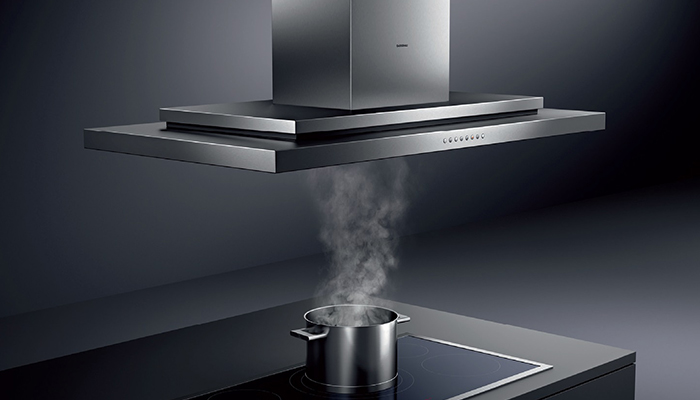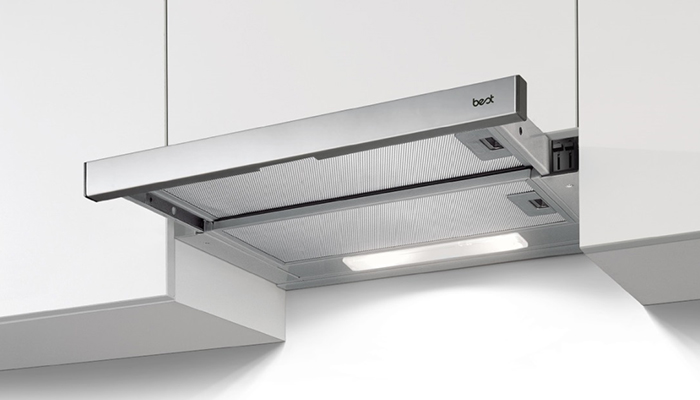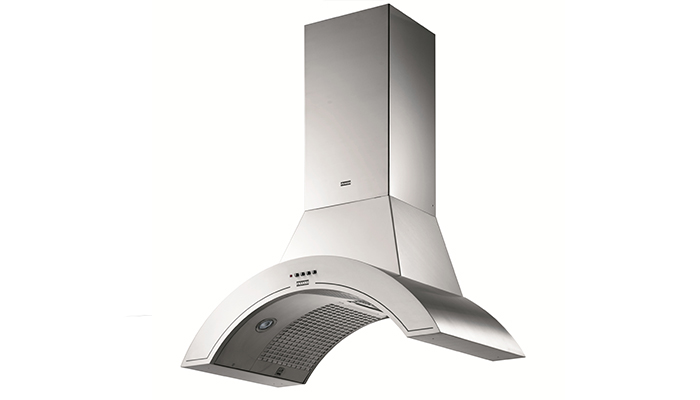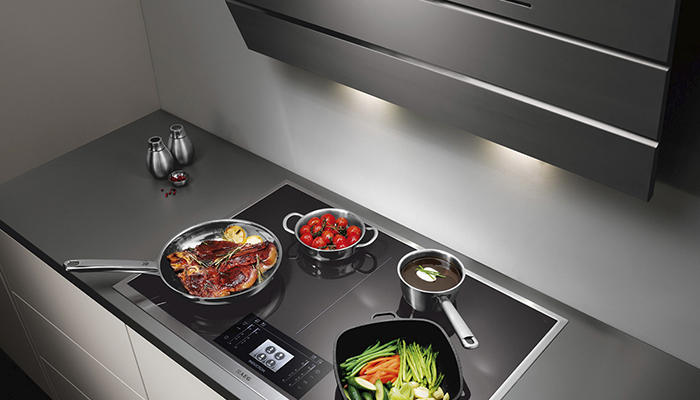Island cooker hoods: reveals the secrets
island ceiling hood for the kitchen set in the middle of the suite kitchen facilities («Kitchen island»). zone, where the washing, plate and working surface, moves from the wall surface and the angular space in the central part.
Features of island hoods
Recessed and domed hood hung on the wall or inserted a special hanging lockers. From these devices island hoods for kitchens They differ only in the method and installation location. Here are the main differences between island hood for the kitchen. According to the principle of work, they are divided into two types:
- recirculation. These devices are not polluted air is drawn into the street, a clean and recycled back to the room. Air, intense smell of cooking, grease and grime, absorbed in the pump apparatus, cleaned through the filter system and fed back. The peculiarity of this type of hood - saving heat in the room (This technique brings back the air without heat loss), which it is an advantage in cold weather. Their installation easier, but the performance below.
- exhaust. These conventional apparatuses emit waste air mass outside through the vent hole or shaft. Therefore, a prerequisite for installing the ventilation system is the presence of. In place of polluted air mass flows through the fresh air vents, oxygenated. But in winter it helps cool the room. These devices are more effective in comparison with the recirculation devices, but they are more difficult to mount.

Now, most of the models are made in a universal version: She works as a hood, and as a filter. The list of additional features wide. is he, by and large, and determines the final price of the product. Additional features:
- backlight;
- stepless speed regulation;
- timer;
- built-in speakers;
- interval switching on and off.
selection
An extensive range of products: in catalogs and stores represented cylinder model, T-shaped devices, devices with glass inserts. In appearance, ceiling hoods for the kitchen are divided into three types:
- The flat plate of small thickness,. These models look light and weightless, without cluttering the interior. Especially popular are the folding hood, which after cooking can be raised to the ceiling. Such a solution increases the kitchen space.
- Dome. These extracts will be perfect for the spacious and bright rooms in the style of high-tech and retro. It copes well with the task of purifying the air due to the shape and powerful electric motor.
- Flat panel with a bend. This combined embodiment, It combines the advantages of the two previous types. A curved dome is made of steel or glass.

design kitchen with an island hood looks rich and elegant. Manufacturers provide customers the opportunity to order a unique pattern of unusual design (shaped lampshade, inverted glass, drops, pipe or UFO). Copper extraction for cuisine different special glamor and luxury.
The Russian market is deservedly popular ceiling extractor Siemens LC 95950 (Germany). Characteristic minimalist details, simple lines, clarity of forms fit perfectly in a modern kitchen. Technical parameters also at altitude:
- power up 800 cubic meters per hour;
- three grease filter of metal mesh;
- two modes of operation (drainage and circulation);
- electronic control;
- 4 speed;
- Two control panels;
- lighting (4 halogen light bulbs).
Specifications
When selecting island hood pay attention to the following technical specifications:
- Power (main index). In accordance with the sanitary standards the air mass in the kitchen should be updated at least 10-12 every time. calculate power, necessary for quality work drawing, simply: multiplied by the amount of space 12 and add a small margin, since there is the resistance loss of the filter and to overcome the duct. figures are most often found in the data sheet from the suction devices 250 to 600 cubic meters per hour. There are models with larger capacity from 900 to 1200 cubic meters per hour.
- sound level. Completely silent hoods have not yet invented. Noise indicators to 40 dB are considered optimal (Modern expensive devices). Inexpensive models have indicators in the area 50-55 dB.
- dimensions. Dimensions stretcher must conform and size of the cooking surface. Among the standard options - 60, 90 and 120 cm.

Extractor hood must cover plate on 10-20 cm, then all the odors and grease will be completely absorbed by the device.
installation
The recirculation device mounted just, because they do not need to have the air ducts. If the device works on the principle of flow-through, to establish an island hood in the kitchen heavier. But if a person knows how to use power tools and understands the concepts of building, the installation of island hood did not take long.
When installing the ceiling hood must be remembered, that vents it's best to lay the future of the suspended ceiling. Fabric ceiling will hide all the communication. Otherwise, you need to consider, how to disguise ducts. Therefore, to begin to lay the wiring and mount the air ducts. These communications are placed under the ceiling, and then close the suspended ceiling systems.
Ducts is better to choose plastic (round or rectangular shape), as they, unlike corrugations, creates less noise. But flexible ducts easier to bend, can not be said about the hard airbox. ductwork, Unlike other extracts, vertical. This work is done at the stage of repair, the rest after the end of finishing the interior.
Since powerful extractor device, then it is connected to a single grounded outlet. If there is no power outlet nearby, it will have to mount or directly connect the hood to the wiring and protective devices in the distribution box. Sequencing:
- Attach the mounting plate, where the design is fixed. Attach the hood to the ceiling can not be directly, since it has a lot of weight (tens of kilograms).
- Secure hood adjusting bolts, special using cables or pins, depending on the type of device. Unusually look hoods island on the ropes for the kitchen.
- Connect the unit to the wires and ducts. Wires connected to terminals via. The air duct is connected with the plastic ventilation pipe and the compensatory.
- Install protective decorative boxes. Vent closing regular casings. Their customize the size and connected around the duct.
Ceiling hood - the device is not cheap. The question is:, worth the risk, and in case of failure to re-embed the unit. It is better to turn to professionals, which set the unit in compliance with all the rules. In the case of incorrect installation it is possible to make a claim to the master.
